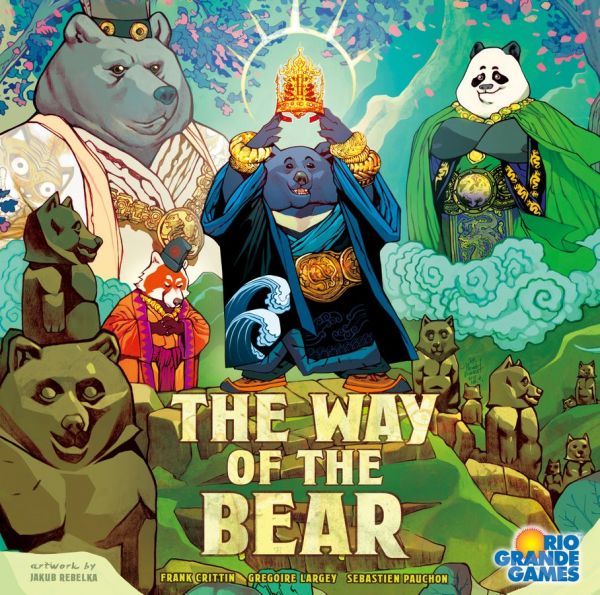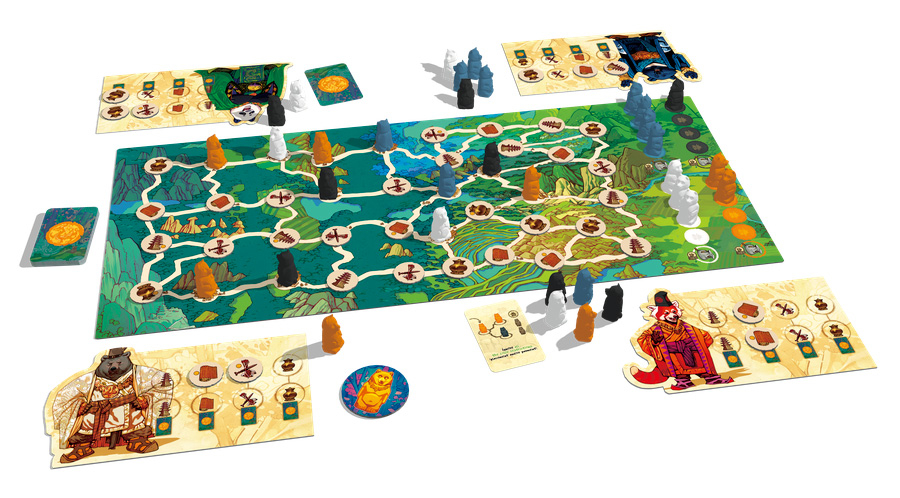The Way of the Bear: A Shocking Defeat and a Casual Victory

At the 2019 World Boardgaming Championships (WBC), Rio Grande Games took something of a sharp turn in the direction of games not likely to be listed in this publication. Underwater Cities was the event’s Open Gaming 'buzz', and with Beta Colony and New Frontiers, their batch of games on display for learning purposes only (not sales) seemed to indicate a strong predilection for the more complex — although that, in itself, is a relative term. Full disclosure: I have been, over the past five years or so, Rio Grande Games’ representative at the WBC in what’s known as Café Jay; an area set aside for the company to display and teach its new batch of games every year. Named after the company’s founder and owner, Jay Tummelson, Café Jay was originally set up in the convention’s home at the time in Hunt Valley, MD. It later moved on to the Lancaster Resort in Lancaster, PA, where Mr. Tummelson first asked me to take over the job, six years ago. It has since moved to the Seven Springs Resort in Pennsylvania, where I was preparing to go, until, of course, the pandemic came along and spoiled those plans.
Not, however, before I had been sent a preliminary shipment of games that I set out to learn in the (as it turned out) vain hope that the WBC would happen. This year’s batch of Rio Grande games seemed to have reversed course, in that a number of the games were definitely well within the parameters of The Casual Gamer.
I’m here to tell you about one of them — The Way of the Bear, designed by Frank Crittin, Gregoire Largey, and Sebastien Pauchon, with artwork by Jakub Rebelka. Its ability to be defined as a 'casual game' might best be demonstrated by the story of how I, seasoned gamer that I am, was promptly defeated by a 7-year-old girl playing it for the first time.
How did it happen?
The first time the 7-year-old’s mother and I sat down to play this, we attempted to enlist the child in gameplay, with the mother making an attempt at persuasion by explaining to the child that it "would be fun to play with all the little plastic bears." This did not phase the child, who promptly opted to continue playing an Xbox game.
A week or so later, I was called on to child-sit (God forbid she should actually read this and encounter me describing it as baby-sitting) and brought up the idea again. Once again, she prepared to decline, being in the midst of playing some game on a computer. I employed a little guilt trip to get her to try it and after explaining the rules in under five minutes, we set out to play. It took her some time to fully grasp some of its nuances, but when she did, she executed all of her future moves in a way that put her on the path to victory. She won and was thrilled.
We played it again a little while later when we engaged two neighborhood friends (7- and 13-year-old males) to play. I redeemed my wounded pride from the first game by winning this time, but it came down to a tie-breaker.

Ok, so what have we got here?
It’s basically a set collection game, requiring players to place a series of plastic bears (white, orange, black, and blue) onto a main board, thereby, with each placement, beginning the collection of a series of knowledge tokens (four types; religion, education, military and commerce) that they will then place on their personal board, in an attempt to be the first to fill that personal board, signaling game’s end. Each player will have the same number of turns, so if the first player completes his personal board first, all other players will have an opportunity to do the same on their turn. If more than one person, or everybody fills their board, this ‘tie’ is broken by counting the number of Dragon Seals (a rounded, gold symbol on some of the tokens). The person with the most wins. Still tied? Shared victory.
The main board is the map of a region in Northeast Asia, where according to legend and the description of the game, there were four bear clans who helped the King of this region to reign. Well, it seems that the King was about to retire and sent his princes, one of whom would inherit the throne, out into the world to acquire the qualifications necessary. He sent them out from town to town (on the map, each town, interconnected by roads, has a randomly selected knowledge token on it), where they would erect sacred bear stones (called "steles" in the game) and collect the requisite knowledge to inherit. At the start, players randomly place all of the knowledge tokens onto the board’s 'towns.' There is also a 'temple track' on the main board, which, at the start, houses one of each type of bear at the top of a designated column (five spaces) for that color.
Each two-sided personal board in four colors (yellow, blue, green, and red) has spaces for the placement of the acquired tokens. In a two-player game, utilizing one side of the board, each player will be looking to acquire 12 tokens. In a 3- and/or 4-player game (using the other side), players will be looking to acquire eight tokens. In a four-player game, players will add a puzzle-fitting addition to the main board, allowing for an extra eight tokens.
Players begin with three randomly-chosen steles (the bears) and four steles are placed on the board; the tokens placed on the board include four tokens with the picture of a bear. These four tokens are replaced with randomly-chosen steles at the start.
A player has two choices on his/her turn; acquire more bears, or acquire a knowledge token. To acquire more bears, you may take two of your choice from among those displayed on the temple tracks or select three randomly from the bag in which they’ve all (84, minus what the players have) been placed. To acquire a knowledge token, you must place a bear onto a town site, adjacent to a town with a bear already on it (remember, you start with four already on the board). When you do this, you must pay for the knowledge token with a bear (or bears) in your possession that matches the color of any bears adjacent to the town in which you’re collecting the token. You cannot place bears of the same color in adjacent towns. Place the bear in the town with the token, take the token and place it in its appropriate place on your personal board. Pay the associated ‘cost’ by placing the requisite bears in their appropriate slots on the temple tracks. In the early stages of the game, you can do this by paying only one bear because there’ll only be one town with a bear, adjacent to where you want to place a bear/collect a token. As the game progresses, acquisition of tokens can cost up to three bears (when an individual token is surrounded by three towns with bears already in them).
The four temple tracks can (and do) become filled. The person who’s filled one track when they pay for a token will take all of the bears on the filled track and put them in the bag. He/she may then select one bear from any of the remaining temple tracks with bears on them.
Your personal board is arranged in four columns, one for each kind of knowledge token. When you complete a column (all the same kind of token), you are able to draw a card from a deck of 16, which will, going forward, give you some valuable bonuses; the ability, for example, to pay one less bear to claim a token, or the ability to choose any color(s), rather than be required to match the colors in adjacent towns, or the ability to switch the location of two adjacent items (tokens or bears), or (and this proves to be very significant) add Dragon Seals to the amount on your acquired tokens. I won the last game with the pre-teens because I had managed to collect the Seal card with three Dragon Seals on it.
Final thoughts
This is a textbook casual game, yet for all of its simplicity, the combination of the race to a finish line and the thinking necessary to make informed decisions about how to collect the specific tokens you need, give this game just the touch of a complex 'spice' that makes it a fun experience, even for guys or gals who can’t wait to sit down for their next eight-hour game of Twilight Imperium. As casual games go, it's truly a victory in game design.
As a matter of casual advice (for the casual gamer, of course), I would recommend that players look to acquire tokens across their personal board, rather than finish one column at a time to collect a Seal card. As the board’s towns begin to fill and the tokens dwindle in number, the requirements become increasingly specific and more difficult. It’s best, in my humble opinion, to acquire those Seal cards, offering different kinds of bonuses, late in the game, as the necessity for the benefits increases.
But hey, that’s just me.
Stele definition: an upright stone slab or pillar bearing an inscription or design and serving as a monument, marker, or the like.




